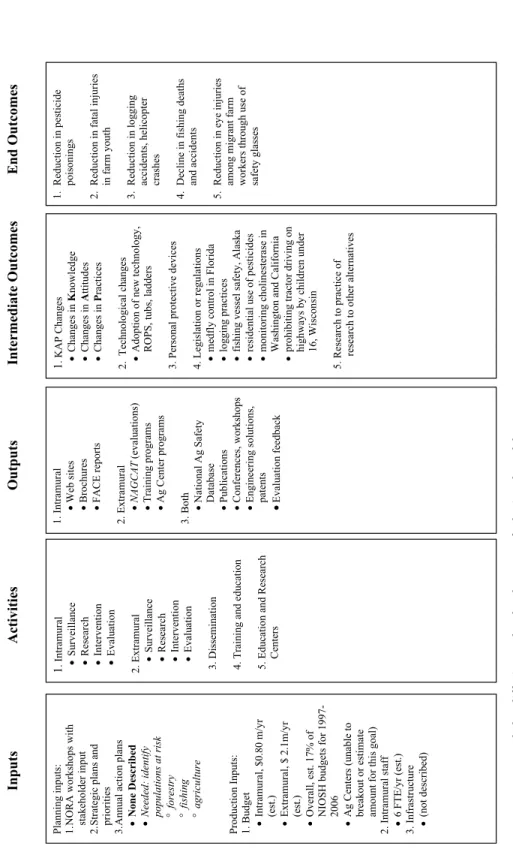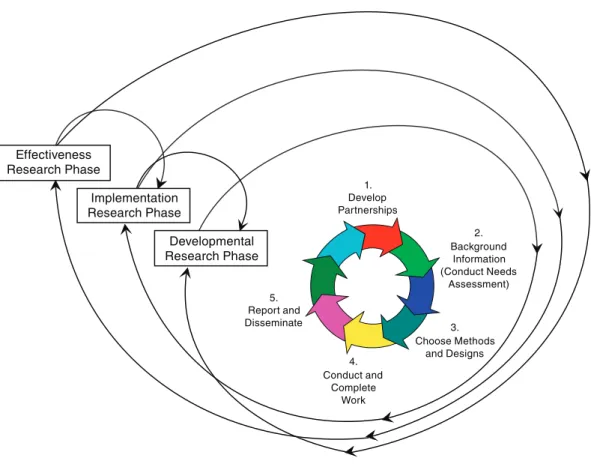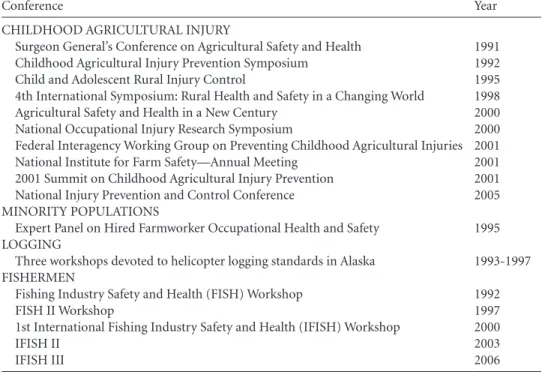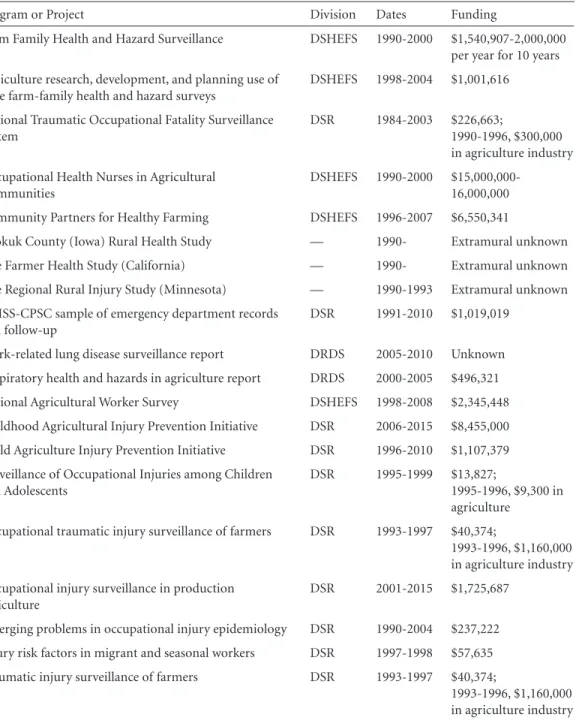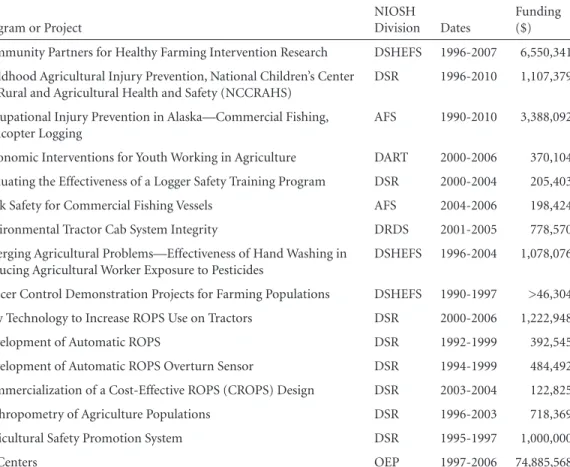Taking into account several important factors beyond the control of the program, the committee found that from 990 to 006 (the period covered by this review) the AFF program made a significant contribution to improving the safety and health of workers in agriculture, forestry and fisheries. . The review of the AFF program was based largely on written materials provided by NIOSH (see Appendix C). The committee notes that the NIOSH AFF program has made a significant contribution to improving worker safety and health.
The AFF program is the only federal research program dedicated to improving the safety and health of agricultural, forestry and fisheries workers. As such, the AFF program should be the definitive leader and source of expertise in occupational safety and health in agriculture, forestry and fisheries.
InputsActivitiesOutputsIn
Hazard Surveillance—Reduce injuries and illnesses in the agriculture, forestry, and fishing workforce by understanding the characteristics of those inju-
The other planning input referenced in the evidence package was the report of the National Coalition for Agricultural Safety and Health (Appendix 2-01 in NIOSH, 2006a), which suggested that adequate population-based rates were not available for diseases and injuries agricultural. , therefore surveys should be conducted on the health and risk of agricultural workers. Significant efforts related to fatal injury surveillance in Alaska's fishing sector have been conducted with evidence that Gulf Coast fishing is being addressed by one of the NIOSH Centers for Research, Education, and Prevention of Agricultural Diseases and Injuries (Ag Centers). The surveillance-related activities and funding identified in the evidence package (NIOSH, 2006a) and through a review of other materials provided by NIOSH and available on the NIOSH website are detailed in Table 4-1.
Absent from surveillance activities mentioned in the evidence package and supplemental materials were other illness and injury outcomes on the National Occupation Research Agenda (1996 to present) list (allergic and irritant dermatitis, hearing loss, infectious disease, musculoskeletal disease, and reproductive outcomes). ). AFF surveillance should be a key priority of inpatient program activities so that the correct information is used to plan future directions. The report and some of its recommendations were briefly mentioned in the evidence package (page 174 of NIOSH, 2006a).
Although NIOSH was encouraged as early as 1992 to address bias in control efforts related to Midwestern, Caucasian perspectives and values, the preponderance of efforts reviewed indicates that such views persist in the agricultural sector (Lee and Gunderson, 1992). NIOSH sought to obtain information on the number of tractors in use in the United States that do not have a ROPS. In the evidence package (NIOSH, 2006a), program staff cited as interim results related to hazard control one NIOSH Alert on Hazards on Agricultural Machinery (1993), one state FACE investigation of the use of Micotil 300® (tilmicosin) in cattle (to prevent seasickness) that resulted in the death of a farmer due to self-injection, and the resulting workplace solutions document and additional warnings from Elanco to all purchasers of Micotil (NIOSH, 2006a).
In the agricultural sector, the AFF program presented information on research among selected populations, while for the forestry and fisheries sectors, all workers were considered special populations.
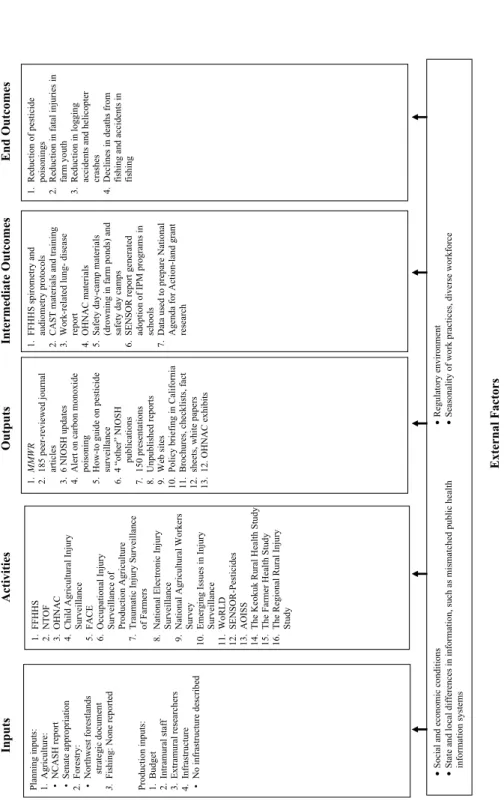
Priority Populations at Risk—Reduce injuries, illnesses, and fatalities in subgroups of the working population determined to be at high risk or under-
These efforts culminated in the adoption of standards by OSHA in 1994 that incorporated many of the recommendations made by the ASF Program. Furthermore, we cannot determine whether the results of the report on children in agriculture were used as a basis for intervention programs. No specific date has been given for the completion of the document and distribution of the results.
The use of standard approaches to the dissemination of farm worker information is evident throughout the AFF program and ignores social and cultural differences in terms of preferred modes of communication, as well as literacy and language barriers. Based on the recommendations, three interventions were carried out; the success of the recommendations cannot be determined from the information provided. No data was provided on the long-term effect of the project on the reduction of lobster injuries.
Work on the distribution and effectiveness of the e-stop continues, but it appears that it will be installed in many vessels. Five statements given after a 2006 pesticide training workshop are offered as examples of the intended use of extramural AFF program efforts. These interim results address a small percentage of the overall activities involving migrant workers that have been carried out by the AFF programme.
The AFF program conducted an evaluation of the effectiveness of a commercial fishing fatality prevention training program for AMSEA.
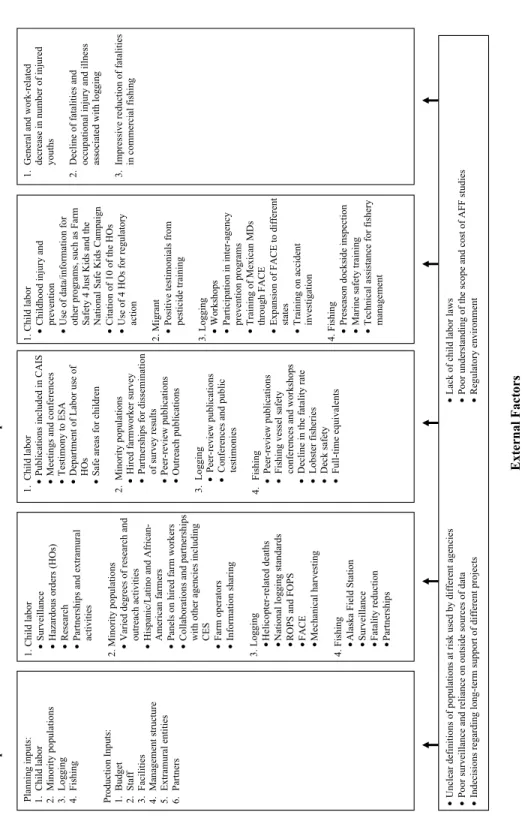
Goal 3: Health Effects of Agricultural Agent Exposures—Reduce injuries and illnesses by understanding the long-term, chronic effects of exposure from
Staffing appears to be adequate in some well-defined subprograms, but resources in many other parts of the AFF program do not appear to have provided adequate staffing. This came at a critical point in the history of the discipline and had far-reaching beneficial consequences for the agricultural component of the AFF program. Activities are defined as the effort and work of the AFF program, its staff and its extramural partners.
The committee separated its assessment of the health impact research portion of the AFF program into an assessment of National Traumatic Occupational Fatality (NTOF) Surveillance System activities and industry-specific activities. As mentioned in Chapter 3, the regional focus of the Ag centers has led to a diversity of approaches and issues and has been a strength of the AFF program (see Table 6-1). The AFF program has promoted extensive research on traumatic injuries nationwide; deaths and disabling injuries make up a significant portion of inpatient and outpatient research.
NIOSH AFF staff and NIOSH Ag Centers leadership gave respiratory disorders a high priority. The AFF program was one of the first to fund a study of gene-environment interactions in the farm setting. Part of the work has been done on effective inter-institutional cooperation relations, especially through AHS.
The output of the NIOSH AFF program related to infectious diseases was modest.
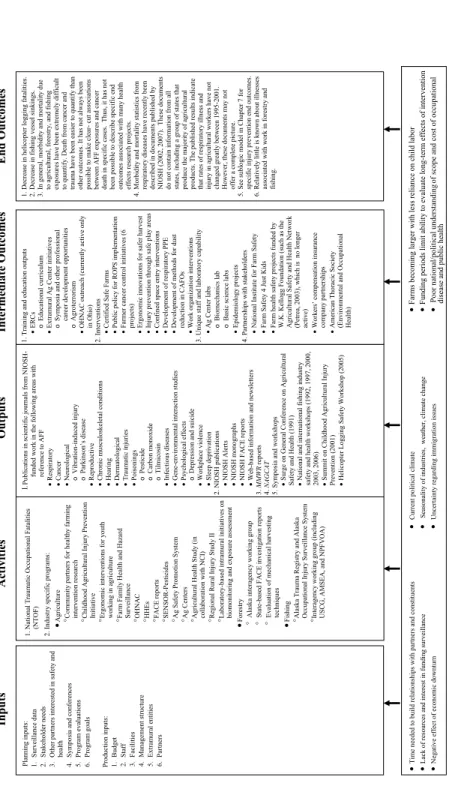
Priority Populations at Risk—Reduce injuries and fatalities among subgroups of the working population determined to be at high risk or underserved
The National Institute for Occupational Safety and Health (NIOSH) Agriculture, Forestry, and Fisheries Program (AFF Program) has devoted significant resources to developing and evaluating interventions that focus on the agriculture, fisheries, and forestry industries. The program review shows that research-related intervention projects encompass several of the established goals of the ALF Program, including those focusing on Priority Populations at Risk (Goal 2), Health Effects of Exposures to Agricultural Agents (Goal 3), and Systems of Risk Control. (Aim 4).
Goal 3: Health Effects of Agricultural Agent Exposures—Determine the chronic effects of agricultural exposures/health outcomes from toxic exposures
Goal 4: Hazard-Control Systems—Reduce injuries and illnesses resulting from work-related exposures by developing, demonstrating, and making available
Much of the AFF program's activity has been devoted to intervention research aimed at addressing the most serious outcomes. Funding ($) Community Partners for Healthy Agriculture Intervention Research DSHEFS Childhood Agricultural Injury Prevention, National Children's Center. Intervention research related to fishing vessel fatalities has been the focus of several intramural and extramural projects, including training on safe commercial fishing in Alaska, injury prevention in the commercial fishing industry (at the Alaska Field Station, AFS), on-board safety for commercial fishing vessels (AFS) and Alaska Occupational Injury Prevention (AFS).
The AFF program has supported numerous intervention research activities focused on the most common outcomes. The AFF program collaborates extensively with numerous organizations at the national and local level in conducting intervention research. Intervention research output included publications relevant to both sexes, vulnerable populations (children, fishermen, loggers and orchard workers) and health disparities (skin cancer).
AFF program intervention research activities have resulted in numerous training and education outputs that are used in the workplace or in school or apprenticeship programs. The AFF program has provided several examples of standards, regulations, public policy and voluntary guidelines related to intervention research. Those end outcomes are only a sampling of the outcomes attributed to AFF program intervention research.
Programs involved in intervention research have described various external factors important to the AFL sector.
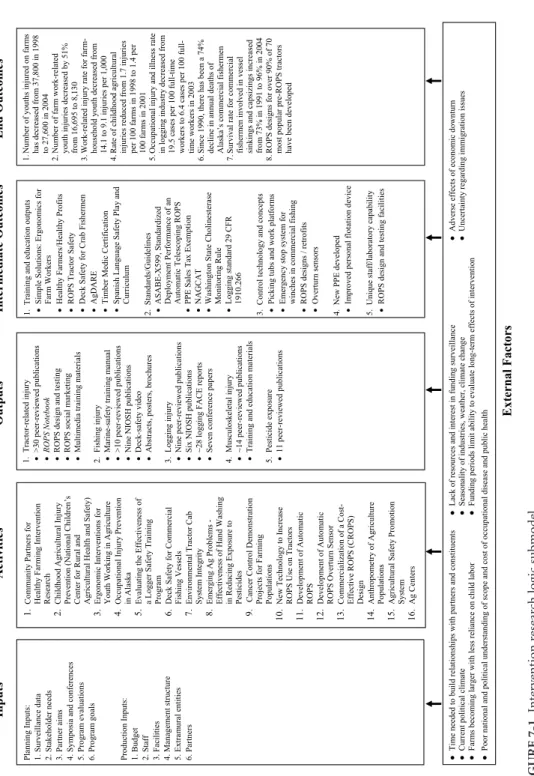
Outreach—Reduce injuries and illnesses by informing and educating employers and employees in agriculture, forestry, and fishing (AFF) about occupa-
It is widely recognized and widely used by the diverse community involved in agriculture (farmers, agribusinesses, universities and government agencies). The website receives over 500,000 visits per month from 75,000 unique users. REVIEW OF THE NIOSH CENTERS FOR AGRICULTURAL DISEASE AND INJURY RESEARCH, EDUCATION AND PREVENTION (AG CENTERS). Other National Institute for Occupational Safety and Health (NIOSH) programs also have a variety of stakeholders, but ALF's stakeholders—the program's ultimate beneficiaries—are an extremely diverse constituency.
Despite those successes, both hired and contract workers have been underrepresented in the short history of the AFF program. NIOSH describes the emphasis as follows: “The core areas of the programming are industrial hygiene, occupational health and safety, occupational medicine and occupational safety. That initiative has led to other activities in different communities: the agricultural, technical, clinical, and health research communities;
The AFF program conducted 16 investigations as part of the agency-wide Fatality Assessment and Control Evaluation (FACE) program. As the NIOSH AFF Evidence Package points out, “the program provided information to support new OSHA standards related to logging, field sanitation, air pollution (suspended in 1992), and ergonomics (repealed in 2002) (Luginbuhl, 1997). This section of the report comments on the AFF program's evaluation initiatives as presented in the evidence package (NIOSH, 2006a) and other evaluation activities discovered during the program review.
Watertight integrity and vessel stability are leading causes of vessel losses and deaths, as demonstrated by the Arctic Rose sinking in 2001 which resulted in the loss of 15 lives - the largest loss of life in US diving fatalities - The 1997 Alaska Diving Safety Workshop (at which a member of the Alaska Field Station), sponsored by the Alaska Marine Safety Education Association (AMSEA) and Alaska Sea Grant, led to new diving regulations in Alaska and led NIOSH-supported AMSEA to develop an educational video on diving harvest safety has. which introduces diving tenders to vessel safety, basic diving operations and diving emergencies. The NIOSH Ag Centers are an invaluable component of the AFF program and have contributed to its successes.
